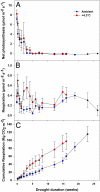Temperature sensitivity of drought-induced tree mortality portends increased regional die-off under global-change-type drought
- PMID: 19365070
- PMCID: PMC2678423
- DOI: 10.1073/pnas.0901438106
Temperature sensitivity of drought-induced tree mortality portends increased regional die-off under global-change-type drought
Abstract
Large-scale biogeographical shifts in vegetation are predicted in response to the altered precipitation and temperature regimes associated with global climate change. Vegetation shifts have profound ecological impacts and are an important climate-ecosystem feedback through their alteration of carbon, water, and energy exchanges of the land surface. Of particular concern is the potential for warmer temperatures to compound the effects of increasingly severe droughts by triggering widespread vegetation shifts via woody plant mortality. The sensitivity of tree mortality to temperature is dependent on which of 2 non-mutually-exclusive mechanisms predominates--temperature-sensitive carbon starvation in response to a period of protracted water stress or temperature-insensitive sudden hydraulic failure under extreme water stress (cavitation). Here we show that experimentally induced warmer temperatures (approximately 4 degrees C) shortened the time to drought-induced mortality in Pinus edulis (piñon shortened pine) trees by nearly a third, with temperature-dependent differences in cumulative respiration costs implicating carbon starvation as the primary mechanism of mortality. Extrapolating this temperature effect to the historic frequency of water deficit in the southwestern United States predicts a 5-fold increase in the frequency of regional-scale tree die-off events for this species due to temperature alone. Projected increases in drought frequency due to changes in precipitation and increases in stress from biotic agents (e.g., bark beetles) would further exacerbate mortality. Our results demonstrate the mechanism by which warmer temperatures have exacerbated recent regional die-off events and background mortality rates. Because of pervasive projected increases in temperature, our results portend widespread increases in the extent and frequency of vegetation die-off.
Conflict of interest statement
The authors declare no conflict of interest.
Figures



Comment in
-
Lack of direct evidence for the carbon-starvation hypothesis to explain drought-induced mortality in trees.Proc Natl Acad Sci U S A. 2009 Jun 30;106(26):E68; author reply e69. doi: 10.1073/pnas.0904580106. Epub 2009 Jun 8. Proc Natl Acad Sci U S A. 2009. PMID: 19506239 Free PMC article. No abstract available.
-
Poor methodology for predicting large-scale tree die-off.Proc Natl Acad Sci U S A. 2009 Sep 22;106(38):E106; author reply E107. doi: 10.1073/pnas.0908053106. Epub 2009 Sep 15. Proc Natl Acad Sci U S A. 2009. PMID: 19805249 Free PMC article. No abstract available.
References
-
- Jentsch A, Kreyling J, Beierkuhnlein C. A new generation of climate-change experiments: Events, not trends. Front Ecol Environ. 2007:65–374.
-
- Shaw JD, Steed BE, DeBlander LT. Forest inventory and analysis (FIA) annual inventory answers the question: What is happening to pinyon-juniper woodlands? J Forest. 2005;103:280–285.
-
- Gitlin AR, et al. Mortality gradients within and among dominant plant populations as barometers of ecosystem change during extreme drought. Conserv Biol. 2006;20:1477–1486. - PubMed
Publication types
MeSH terms
Substances
LinkOut - more resources
Full Text Sources

